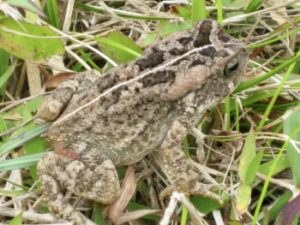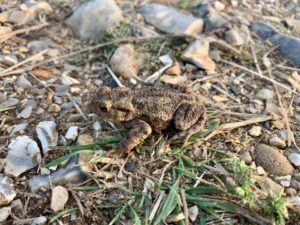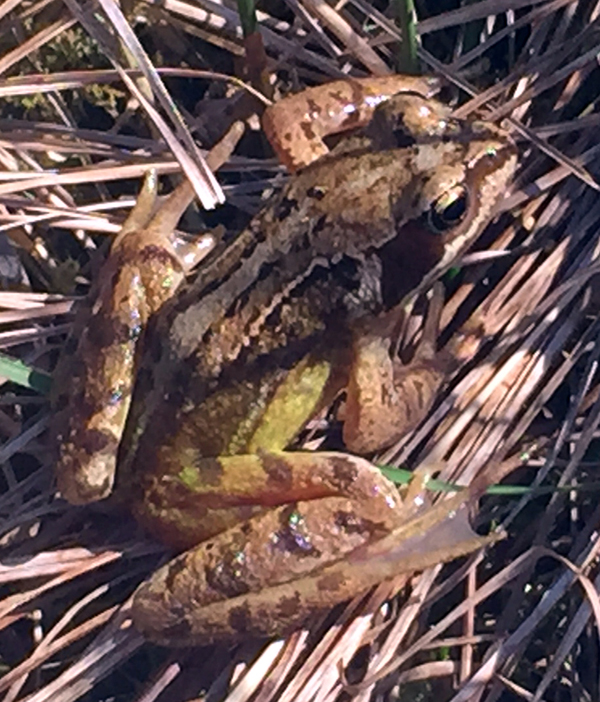Toad in a hole

Every now and then when sweeping up leaves or tidying in the garden, I am surprised by the sudden hoping of a toad. The common toad (Bufo bufo) has warty, olive-brown skin, and short back legs. The toad tends to walk rather than hop (which it does if surprised). Toads are found almost everywhere across the U.K, except for islands like those around Scotland, the Isle of Man and Channel Islands. They are terrestrial amphibians, returning to water to breed.
Sadly, cities and towns pose a threat to toads. Busy roads often block their migration paths, making it difficult for them to reach breeding ponds. Many toads are killed on our roads each year. Toads are adaptable and may be found in deciduous and coniferous forests, meadows, parks, scrubland and gardens. They prefer damp areas with plenty of foliage.
However, a recent survey into hazel dormice and bats revealed that a number of toads could be found in trees.  Whilst it was known that toads favour woodlands as foraging and entering habitat, it was not known that they could be found in tree cavities (used by bats), or in hazel dormouse nest boxes (some 1.5 metres above ground). One toad was found three metres up a tree. The toads were not found in holes or boxes with other species but it was clear from the study that they would make use of old nests made by dormice or even birds, or natural holes. The conclusion of the survey was that toads can and do make use of trees, particularly those near ponds or lakes. Why they climb and make use of trees is not clear. It could be that
Whilst it was known that toads favour woodlands as foraging and entering habitat, it was not known that they could be found in tree cavities (used by bats), or in hazel dormouse nest boxes (some 1.5 metres above ground). One toad was found three metres up a tree. The toads were not found in holes or boxes with other species but it was clear from the study that they would make use of old nests made by dormice or even birds, or natural holes. The conclusion of the survey was that toads can and do make use of trees, particularly those near ponds or lakes. Why they climb and make use of trees is not clear. It could be that
- they are searching for food,
- trying to avoid predators (hedgehogs, rats, grass snakes, and birds (such as herons and crows), or even
- avoiding parasites (such as the toad fly, the larvae of which feed on the flesh of a toad).)
Toads generally lie ‘hidden’ during the day., becoming active at dusk. Nightime is spent hunting for the woodlice, slugs, beetles, caterpillars, flies, and earthworms on which they voraciously feed.
It might be that ancient / veteran trees that are known to support a wide variety of animals, may harbour a toad or two.
If you want to report sightings of any amphibians you can use the “Dragon Finder App”.
 This enables you to Identify adult reptiles and amphibians as well as their eggs, and larvae. You can submit your observations and use your smart phone’s GPS function to determine your location or pick from a map.
This enables you to Identify adult reptiles and amphibians as well as their eggs, and larvae. You can submit your observations and use your smart phone’s GPS function to determine your location or pick from a map.
Comments are closed for this post.
Discussion
Not true about channel Islands….I’m from Jersey, plenty of toads there!
You can often see toads in woodland on mild wet nights (it’s best when it’s raining!) when they are foraging for food such as slugs, snails, worms, beetles etc.
Take a powerful torch and look for them on paths and glades or any areas of more open habitat. Keep disturbance at a minimum and don’t shine the light directly into their eyes as they have ultra sensitive night vision.
Young toadlets can be seen leaving their breeding ponds en masse , usually in late July/August on wet nights after prolonged dry spells. The woodland floor can often be covered in hundreds of tiny toadlets but only a very small proportion will survive the 3 or 4 years before they are mature enough to return to the pond to breed.

I love toads. I try hard to make my area inviting to toads. One time I was helping my mother unload groceries when she cupped and covered her hand and asked me to “Guess what?” A teeny, tiny toadlet smaller than my little fingernail! I kiss toads for good luck.
Sharon
18 September, 2022